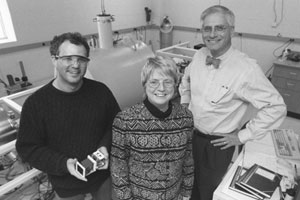Madeline Amy Sweeney, known as Amy Sweeney (1966 — 11 September 2001), was a flight attendant on board American Airlines flight 11 when it was flown into the North Tower of the World Trade Center as part of the September 11, 2001 Terrorist Attack. She relayed information about the hijacking on board by phone to Michael Woodward, an American Airlines flight service manager on the ground. Flight 11 was the first plane to crash and her call was apparently the first news of the hijackings.
It is not known exactly where on board she was calling from. Information relayed included the seat numbers and descriptions of four of the hijackers, although the FBI later named five hijackers on board the flight. It is said that the information given enabled investigators to link the day's hijackings to Al-Qaeda.
Her report was delivered in a calm, deliberate manner to the very end. According to reports based on Woodward's notes [1][2], at 8:44 Sweeney said: "Something is wrong. We are in a rapid descent... we are all over the place."
(Woodward asks her to look out the window to see where they are.)
"I see water. I see buildings. We are flying low. We are flying very, very low. We are flying way too low. -pause- Oh my God, we are way too low." The flight impacted at 8:46:40.
She was 35 when she died. She had been a flight attendant for 12 years. She was survived by her husband and two children, ages 4 and 6. They lived in Acton, Massachusetts. She normally only worked weekends but had chosen to do an extra shift that day.
On 11 February 2002, she was commemorated in a series of new annual bravery awards initiated by the Massachusetts government. The annual Madeline Amy Sweeney Award for Civilian Bravery[3] will be awarded every September 11 to at least one Massachusetts resident who displayed extraordinary courage in defending or saving the lives of others.
The first recipients were Ms. Sweeney and fellow flight attendant Betty Ong, who had also relayed information about the hijacking to personnel on the ground. Pilot John Ogonowski also received a posthumous award for turning a radio switch on and thus allowing ground control to listen to remarks being made by the hijackers. All three had been Massachusetts citizens.
Relatives of all three accepted the awards on their behalf.
 Amy in documentaries and Motion Pictures
Amy in documentaries and Motion PicturesAmy Sweeney was played by Irene Carl in the documentary The Last Hour of Flight 11 and by Jeniffer Ricci in the ABC miniseries The Path to 9/11 opposite Jean Yoon and Patricia Heaton.
 Significance
Significance Movie Roles
Movie Roles
 Punggol, or Ponggol, is a neighbourhood in
Punggol, or Ponggol, is a neighbourhood in 
 Banking system
Banking system

 Early career
Early career
 Acid-base studies
Acid-base studies Personal life
Personal life Strategic Developers
Strategic Developers

 History
History Further reading
Further reading Radio
Radio Lists
Lists Lefthit
Lefthit